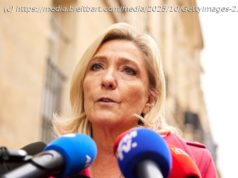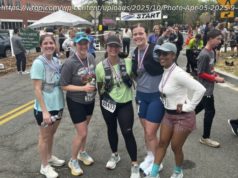 The first visible signs of security measures for Friday’s presidential inauguration soon will be evident — parking restrictions begin Wednesday in the District’s downtown. Streets will start closing on Thursday.
The first visible signs of security measures for Friday’s presidential inauguration soon will be evident — parking restrictions begin Wednesday in the District’s downtown. Streets will start closing on Thursday.
The nation’s capital will quickly transform into a virtual fortress of roadblocks, fences and armed police. Streets will be barricaded with trucks filled with sand. Five Metro stations will close Friday. Crossing Pennsylvania Avenue will be next to impossible.
The peaceful transfer of power is made possible by overlaying a tight security grid using 28,000 security officials over 100 square blocks of prime downtown real estate — from the White House to the Capitol and beyond, with a price tag in the tens of millions of dollars.
An estimated 700,000 to 900,000 people are expected to watch Donald Trump become president. Security officials said there are 63 demonstration groups, pro and con, expected on Jan. 20, and an additional 36 on other days. Those include groups with permits and others who have signaled participation through social media.
To accomplish having a tranquil event amid worries of terrorist attacks and threats by some groups to disrupt the celebration requires bringing in 3,000 police officers from across the nation and 5,000 members of the National Guard, bolstering the already large law enforcement footprint imposed on everyday Washington. The numbers this year are the same as in years past.
“We’re constantly adapting, evolving and enhancing our protective methodology to protect against emerging threats,” said Brian Ebert, the Secret Service special agent in charge of the Washington field office. “We are monitoring our adversaries, paying close attention to their trends and tactics.”
Authorities said it makes little difference whether the Secret Service is protecting Trump, who is known for unpredictable behavior, or someone more apt to follow established customs. They dismissed notions that protecting Trump might be more difficult given his unique personality and the variety of people and groups he has angered.
“A lot of people think it’s different because of the individual,” said Jonathan Wackrow, a retired Secret Service agent who worked on President Obama’s inauguration in 2013 and now runs RANE, a security consulting group in New York. “It’s very much the threat level as a whole.”
But Scott J. White, a professor and director of the cybersecurity program at George Washington University, said Trump’s use of Twitter and the language he uses have spurned outrage that poses new risks.
“There are elements of the president-elect’s behavior that may pose a slightly greater threat,” White said. “I think his use of social media has a tendency to inflame people’s attitude toward him. And I think this particular method of engaging the public has definitely resulted in a different kind of adversary.”
For the most part, security experts said police say they will do what they always have done for such events: snipers on rooftops; boat restrictions in the Potomac and Anacostia rivers; manhole covers welded shut; light poles removed; trash cans and mailboxes hauled away; and multilevel perimeters established along the parade route and viewing areas at the Capitol Building, with metal detectors and bag checks.
The list of prohibited items is long and includes things one might expect — ammunition, weapons, explosives — but also balloons, selfie-sticks, and supports for placards and coolers.
“Bring a little bit of patience,” Ebert said. “We have a lot of checkpoints and we have a lot of people.”
Crowds are expected to be smaller than the 2 million people who attended President Obama’s first inauguration, in 2009, and on par with the 1 million or so who came to his second swearing-in, in 2013. But more protesters are anticipated this year after a polarizing campaign, reflecting divisions evident across the nation.
One group, DisruptJ20, has plans for “massive resistance” with rallies and marches. The group plans a permitted, family-friendly gathering, as well as what it calls “unpermitted anti-capitalist marches,” some targeting as many as a dozen security checkpoints along the parade route and others crashing inaugural balls.
Yolanda Rondan, who works with a group that advises activist groups such as Black Lives Matter raised another concern while testifying Thursday at a D. C. Council public safety committee hearing: whether police are prepared to protect anti-Trump demonstrators from those who may oppose their views or their tactics.
Monica Hopkins-Maxwell, the executive director of the ACLU of the Nation’s Capital, said at the hearing that the “First Amendment is rarely convenient and is rarely comfortable . especially during this inauguration and with this heightened emotion.”
Hopkins-Maxwell said the police should make every effort to single out instigators in an otherwise orderly crowd and not use isolated incidents to disperse an entire group or start mass arrests.
Demonstration organizers have planned for housing and legal support, as well as transportation. The ACLU is distributing 10,000 pamphlets called “know your rights guide” to help demonstrators who may encounter law enforcement.
District officials said officers from local and federal agencies are prepared for any unrest and both the mayor and police chief have said they will allow people to express their views but won’t allow violence from either Trump supporters or Trump critics. “We expect people to exercise their rights peacefully, and we will be prepared for anybody who chooses not to,” said D. C. Mayor Muriel E. Bowser (D).
Homeland Security Secretary Jeh Johnson said at a news conference Friday that demonstrators could reach the parade route by going through security checks and leaving prohibited items behind. “Peaceful demonstrations are certainly permitted as long as they aren’t violent,” he said. But Johnson stressed, “Special precautions are being taken to ensure that the official event cannot be disrupted.”
Authorities said police have been practicing for months with rehearsals and moving index cards symbolizing demonstrators around a giant map of the District. A team of Secret Service agents is monitoring social media.
The last time violence occurred at an inauguration was in 2005, when President George W. Bush began his second term. A melee at a checkpoint at 14th Street and Pennsylvania Avenue NW injured two officers, and riot police sprayed a group with pepper spray. Police reported being pelted with glass bottles. Fixtures from light poles were torn down.
At Bush’s first swearing-in, in 2001, numerous protest groups roamed the District, some clashing with police, in what The Washington Post described as the largest inaugural demonstration since the Vietnam War. The paper reported than an egg, four green apples and a plastic water bottle were tossed in the direction of Bush’s limousine as protesters along the parade route shouted, “Hail to the thief.
Домой
United States
USA — Art Security grid for inauguration means thousands of police, many street closures






